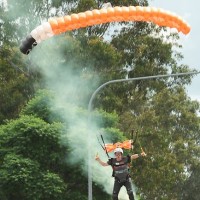Gordon Capital Pty Ltd have released a comprehensive report, examining ISA Group’s growth profile, strategic position and direction.
Read the full report
News

Gordon Capital Pty Ltd have released a comprehensive report, examining ISA Group’s growth profile, strategic position and direction.
Read the full report
Written by Christopher Golis and featured on www.evancarmichael.com.au
This was the title of a Executive Education seminar held last Tuesday night in Sydney hosted by UTS and sponsored by PriceWaterhouseCoopers. Based on the opening speech by the Chair, Dr David Band of UTS, the question posed was driven by the lack of venture capital and government support in Australia and the supposed solution requiring the entrepreneur going to Silicon Valley to raise VC.
There were two first-class entrepreneurs on the panel, Kathy Phelan and Richard White. Kathy is the Founder/CEO of Small World Social, a company which has developed an interactive online platform that puts the person back into the equation by explaining products, assisting people with the understanding of old and new technology and guiding them through complex systems. Richard is the Founder/CEO of WiseTech International, which is has developed several world class products including include CargoWise, a global leader in logistics technology solutions; and eHealthWise, a provider of electronic data services for the healthcare industry.
Both were spending a substantial part of the year overseas not however to raise capital but for reasons of marketing and management. Both used Australia to develop and beta test their products and then went overseas to scale their company.
Interestingly both had raised external capital not from VCs but from angels. The message they both gave was that you needed to be self-funding otherwise you would be screwed by either the VCs or angels no matter where they were located.
With regard to government support Richard is in the camp that believes best thing governments can do is get out of the way. Kathy was of a different opinion. First she described how she used the new Innovation Patents to protect her IP. She said that this had become particularly important when dealing with bankers and investors. She then described herself as first class ferret for obtaining government grants and benefits ranging from Comet Commercialisation grants to 457 visas. She had estimated that for the two businesses she had launched she had collected over $6 million in benefits.
While the question posed was never answered I would make the following observations.
The venture capital industry in Australia is effectively moribund. If the Australian Superfunds invest in venture capital they invest in USA venture capital funds. Interestingly USA VCs are now investing in Australian companies. This is a round-about way of getting there but it does seem to be occurring.
However there is has been major rise in angel funding in Australia. In addition the window for IPOs in Australia is beginning to open and this will probably be a major source of capital over the next five years. Indoor Sky Dive has just raised $12 million which 12 months ago would have been impossible.
If you do go to the US to try and raise capital remember it takes an entrepreneur something like 70 pitches to raise the ‘A’ round from Silicon Valley VCs. There are a lot more VCs there so you can make 70 pitches but it takes a considerable effort to do so.
Don’t underestimate the value of patents. Both Cochlear and Resmed had generated pretty hefty patent portfolio before they set out to raise funding. Finally a smart move, given the strength of the Australian dollar, would be to look to take over a US business in a similar industry rather than do a green-fields start-up.
Visit the original link here
Written by Nick Evans
The dire state of the capital markets for junior miners is clearly evident if you take a quick scan of this year’s IPOs.
The class of 2013 is, so far, a touch ahead of last year, according to IRESS data – 12 successful floats got away at the close of trading yesterday, as opposed to 10 at the same time last year.
But what’s striking about the list is how few resource companies are among that number.
All 10 of last year’s floats came from the resources sector. There were two oil and gas plays, including last year’s stand-out market star Pura Vida Energy with the remainder being traditional exploration juniors from the mining sector.
This year there have only been six. Oil and gas hopefuls Cott Oil and Gas, Strata-X Energy and Tiou Energy; coal plays Malabar Coal and Perpetual Resources; and Chinese-backed uranium explorer Zeus Resources. At a pinch, labour hire firm Oilfield Workforce Group could probably be added to that list.
The list is rounded out with two investment funds, an outdoor advertising and tech company focusing on the Chinese market (China Integrated Media Corporation), clean tech hopeful Ecosave Holdings, and novelty extreme sport company Indoor Skydive Australia Group.
Compare those figures to the situation two years ago. By this time in 2011, the market had welcomed 33 new floats, with 25 in the resources sector – and it becomes even clearer how complete the exodus from the resources sector has been.
Of the current crop, Indoor Skydive is the stand-out. Although it trades on very thin volumes, the company is up 85 per cent from its 20¢ January float, closing yesterday at 37¢. Ecosave, which also experiences light trading volumes, has been the other big winner, up 69 per cent to ¢1.69 from its $1 January issue price.
At the close of trade yesterday, none of the rest were trading ahead of their listing price. Four were trading at their float price, and the remainder were down.
Zeus has fallen most, down 13.9¢ or 69.5 per cent to close yesterday at 6.1¢. Since listening in mid-January at 20¢, the company has not issued a single release to the market about its uranium exploration activities, and has drifted steadily downwards.
Malabar Coal is down 28 per cent and Cott Oil and Gas is off 22.5 per cent. Overall you would be slightly ahead if you had taken a speculative punt on every float so far this year, even though half your investment would be down.
If you had thrown a speculative $5000 into each of this year’s floats, your $60,000 portfolio would currently be worth $60,885.
Written by Sylvia Pennington
Determination, mateship and a big dream have propelled former special forces soldiers Wayne Jones and Danny Hogan from some of the world’s hottest trouble spots to the Australian Stock Exchange.
A scheme to build a $10 million indoor skydiving tunnel, the country’s first, at Penrith in Sydney saw them parachute out of the SAS last year and land in an arena where millions of dollars, rather than life and limb, are placed on the line.
Due to open next January Indoor Skydive Australia’s tunnel will operate as a training and recreational facility for corporate groups, enthusiasts and the military. Similar facilities are planned for Melbourne, Perth, the Gold Coast and the Sydney CBD.
The venture has scored $2 million in backing from another former soldier, Steve Baxter, who made the BRW Rich List after selling fibre optic company PIPE Networks to TPG for $373 million in 2009. ISA floated on the ASX in January.
Dodging bullets was par for the course in Jones’ and Hogan’s previous lives, courtesy of a series of assignments in places most people find little cause to visit.
Between them, the pair have been on every deployment of the past two decades – from Somalia and Rwanda as young infantry soldiers, to stints in East Timor, Afghanistan, Iraq, Fiji and the Solomon Islands with the SAS. Hairy moments notwithstanding, a life in uniform had always appealed, Jones says. “The adventure side of it is why I joined up – to go and see the world.”
Skydiving in a wind tunnel in the US had formed part of their training and Jones’ segue from SAS operative to CEO began with a conversation at the SAS’s 50th anniversary celebrations in 2007.
Hogan says his initial response to the notion of building a tunnel in Australia was sarcasm: “These facilities are expensive – we’ll never be able to afford one.”
The pair mulled the proposition for a couple of years before taking long service leave to “war game” the nitty-gritty of how it could be done.
“I’d never really looked at leaving the military until we started looking at this project,” Jones says.
“We had to move on, we couldn’t do both – we had to set it up properly.”
Meticulous planning had saved their lives in the past and also saved their financial bacon as they navigated the minefield of capital raising and developed contingency plans for every “what-if” imaginable, according to Hogan, ISA’s chief operating officer.
“There were some challenging moments – there always are when you’re presented with the threat of the unknown – but it’s how you process that, is what we’re good at,” Hogan says.
Corporate psychologist Campbell Thompson says drive, clarity of thinking and precision planning are hallmarks of many career soldiers, particularly those who’ve served in adrenalin pumped, sharp-end roles.
“The stakes are high so they learn to focus their efforts,” Thompson says.
“They’re often responsible for a lot of people … it’s a bit like being an elite sportsperson, only even more so.”
Former infantry officer Brad Jones agrees. He says younger years in uniform provided many of the skills that have enabled him to forge a thriving second career building mobile banking systems across the developing world.
Jones’ Singapore-based consultancy Mobile Accelerate helps clients, including the World Bank, develop financial services infrastructure for communities in Indonesia, India and China, where locals transact all their business in cash.
He says army training provides people with a strong methodology to take in information quickly, assess their options and make decisions – often from a very young age.
“Military leaders are taught to articulate their objectives or visions very clearly, create detailed operational plans to support them and provide their teams with flexibility so that decisions can be made and strategies changed on the ground when circumstance demands it,” Jones says.
“These are the sort of people we need more of in business.”
Read the original article here
ISA Group CEO, Wayne Jones chats to 2GB about indoor skydiving and our upcoming vertical wind tunnel at Penrith:

Written by Chris Georgakopoulos
CONSTRUCTION on the first indoor skydiving facility in Australia has started in Penrith.
Premier Barry O’Farrell attended the sod-turning ceremony at Penrith Panthers.
Indoor Skydive Australia Group CEO Wayne Jones said the facility – next to Harry’s Cafe de Wheels – would have wide appeal.
“We will find kids as young as three, families, sporting clubs, national and international tourists lined up to experienced the feeling of human flight,” Mr Jones said.
“Skydiving enthusiasts and military units from around the world, including from our own Australian Defence Force and specialised units from within, will utilise our facility for training in a safe and cost-effective environment.”
The facility is due to be completed by the first quarter of next year.
Panthers Group CEO Warren Wilson said the iFLY concept would become an exceptional part of the club’s precinct.
“A key part of this vision and property is creating the Panthers entertainment, leisure and sporting precinct for not only Penrith but greater western Sydney,” Mr Wilson said.
Mr O’Farrell was delighted to see another development in western Sydney.
“It is a development that will add to the tourism infrastructure in Sydney’s west, which will create and support 220 jobs during construction and initiate 21 jobs during operation,” Mr O’Farrell said.
“Can I also acknowledge the role of Penrith Council and the Penrith Business Alliance, which is undoubtedly the best chamber that I deal with anywhere across the city. They are forward thinking, determined to deliver jobs to this part of Sydney and encourage businesses like this to come forward.”
View the full article here

Written by Tony Featherstone
Indoor Skydive and Osprey Medical worth watching.
Optimists had to dig deep to find positives in last year’s float market. Capital raised was the lowest in more than a decade and listing volumes tumbled. But beneath the float train-wreck has been some surprisingly strong performances that eagled-eyed speculators should follow
Not that you would know it by coverage of the Initial Public Offerings (IPO) market. Micro-cap floats usually get little media and broking coverage before their listing and even less after. The days of using a full-service broking firm for access to floats and research on new companies are a distant memory.
The good news is this lack of coverage creates opportunities in micro-cap stocks for speculators who understand the risks of trading illiquid stocks. Floats have added complications as vendor shares are released from escrow, and able to be sold, within a year or two of listing.
Caveats aside, some IPOs have impressed since listing in the past year. Below are two largely unknown small-caps that have captured the market’s attention this year, but are yet to attract much interest from the mainstream media or sharebroking community.
1. Indoor Skydive Australia Group (ISA)
The tourism operator’s float stood out last year. In an IPO market dominated by explorers, ISA sought $12 million to build Australia’s first simulated skydiving attraction in western Sydney.
ISA looked like a challenging float: it was about to start construction on its attraction and probably a year away from opening it. In a news-hungry market, a dearth of announcements can be a death-knell for small-caps that have to work overtime to maintain the market’s interest.
But ISA shares raced from a 20-cent issue price to as high as 50 cents after their January listing, before easing to 35 cents, on low volume. ISA has plenty of supporters in the skydiving community and its founders’ military connections – both are ex-SAS Regiment soldiers – are a big asset.
The company’s biggest selling point is the success of similar attractions overseas. iFly Singapore was hugely popular upon launch in May 2011, with skydiving enthusiasts and novices eager to experience the thrill of skydiving in wind tunnels. ISA, through its iFly Down Under brand, could have similar success.
ISA needs to leverage its first-mover advantage by expanding rapidly to other states. Smaller attractions are planned for the Gold Coast and Melbourne, and ISA wants the military to use up to 20 per cent of the facility’s capacity, instead of going to the US or UK. Its Sydney facility will be built next to Penrith Panthers Rugby League Club’s main entrance and within 50 kilometres of Holsworthy Army Base.
ISA is obviously speculative. But unlike many micro-caps, it at least has a product that has had strong success overseas, has a well-regarded board, and is potentially within 12 to 18 months of first revenue.
View the full article here

Written by Andrew Carswell
IT will be unabashed luxury, a creative masterpiece, a centrepiece for Australia’s biggest urban development – and it will all be staffed with eager workers from western Sydney.
Billionaire gaming mogul James Packer will build a $10 million college in Penrith to train 1250 staff to work in what he claims will be one of the world’s greatest hotels – his $1 billion six-star Crown Sydney Hotel Resort at Barangaroo. The Crown chairman yesterday signed a deal with the Penrith’s Panthers club that will see the state-of-the-art training facility built within the club’s proposed community centre.
Mirrored on the company’s successful in-house Crown College in Melbourne, which has trained 4300 apprentices in the past 10 years, the Penrith centre will feature a school of business, a hotel and food academy built around a large-scale replica restaurant, and a fully equipped gaming hall.
Under the terms of the memorandum of understanding, Panthers NRL stars will be hired as mentors for for the trainees and, in turn, gain a career pathway after football. Crown will also push into local Penrith schools and create avenues for students to complete school-based traineeships and apprenticeships. Panthers staff also will be given the opportunity to be trained in the college and seconded to work at Barangaroo when required.
For Mr Packer, as with the extensive footprint of his proposed casino resort on Sydney Harbour, location was imperative.
He personally wanted to offer an opportunity to western Sydney, where high-class training avenues are seldom found and luxury-focused hospitality jobs are even rarer, and where his passion for giving the indigenous community the tools for success can be utilised.
“Crown Sydney, if it is approved, will employ 1250 people; this announcement today gets those jobs to where they are needed most – Sydney’s west,” he said.
“This partnership will mean real training and real jobs. It’s not about certificates that go nowhere, it’s about getting people into long-term and secure employment.”
Read the full article

By Nick Sas
The lethargic initial public offering market surrounding small cap stocks is continuing from last year as investors shy away from the challenging market conditions, a leading IPO business accountancy firm says.
Partners at the Perth-based arm of HLB Mann Judd, which handled eight floats last year, say only one IPO is on their books so far this year, with planned market listings well down on last year.
Five companies have come on to the boards this year, including WA-focused uranium explorer Zeus Resources which has halved in value since listing last week.
The challenging conditions are a continuation of last year, with just 46 IPOs completed compared to 104 in 2011. Of the companies that listed last year 48 per cent recorded losses.
Speaking at an IPO breakfast yesterday, A1 Consolidated Gold chairman Ashok Parekh said part of the blame for the lack of confidence in the IPO market should fall on the Federal Government, which had created uncertainty through the mining and carbon tax.
Mr Parekh, who also chairs Macphersons Resources, said the high labour cost environment in Australia also contributed to the lack of investor faith in new listings.
He said many small cap companies had been looking at overseas investors to fill the void as the local markets dried up.
HLB Mann Judd partner Norman Neill said alternatives such as backdoor listings and merger and acquisition activity would become increasingly common this year as private companies looked for alternatives.
However, Mr Parekh said many managers and directors of small caps were too concerned about their own personal salaries to agree to mergers, and were not focused on shareholder wealth.
Despite the doom and gloom, NSW-based Indoor Skydiving Australia, which listed on January 18, has doubled in value from its 20¢ listing price to close at 40¢ yesterday.
Other companies to list so far this year include Perth explorer Cott Oil and Gas, NSW energy and water conservation company Ecosave Holdings and Singapore-based oil and gas contractor Oilfield Workforce Group.

Article by Bevis Yeo
Indoor Skydive Australia Group (ASX:IDZ) has leapt into the ASX after raising almost $7.4 million from its IPO.
The company plans to construct and operate the only large scale commercial indoor skydiving facility in Australia, which will also be the second of its type in the Asia Pacific region.
Indoor Skydive will begin trading at 11am (AEDT) on Friday 18 January.
The planned facility – to be sited within the Penrith Rugby League Club redevelopment at Penrith – will house one of the largest Verical Wind Tunnels (VWT) available in the world and will be able to accommodate up to eight professional skydivers, or two amateurs, at a time for training or entertainment.
Professional sky divers are required ongoing training to remain competitive as do military operators.
As such, VWT infrastructure is complementary to skydiving as it provides virtual or simulated training in a controlled environment that is not subject to weather and other factors.
International organisations have also recommended the use of VWT for simulating training to prepare beginners for full licencing to undertake individual skydiving.
This facility is expecting to start operating no later than January 2014.
Indoor Skydive believes there is potential for it to operate a portfolio of VWTS located throughout Australia, meeting the demand of users located in capital cities and suburbs.